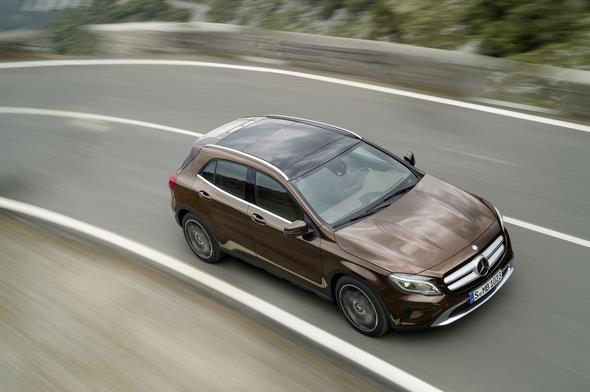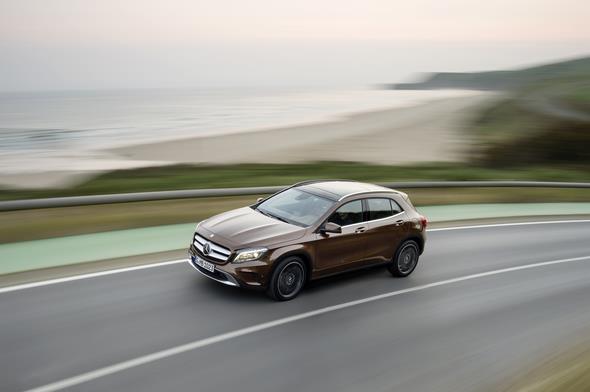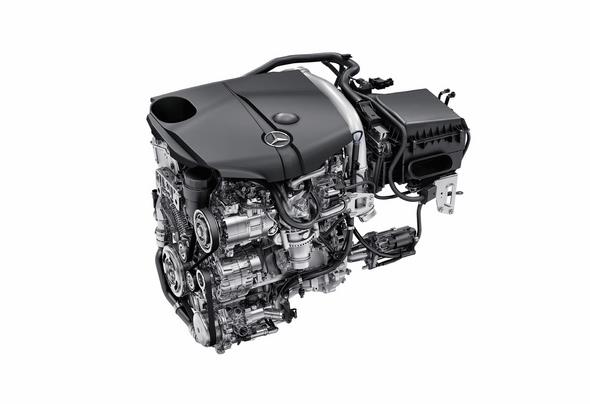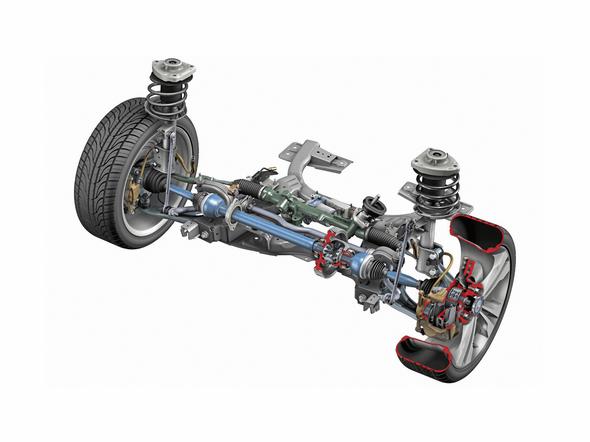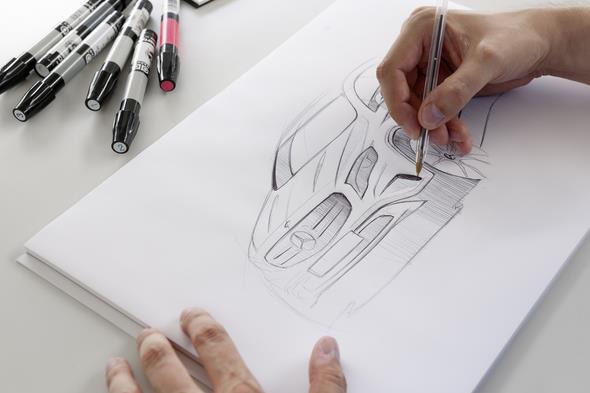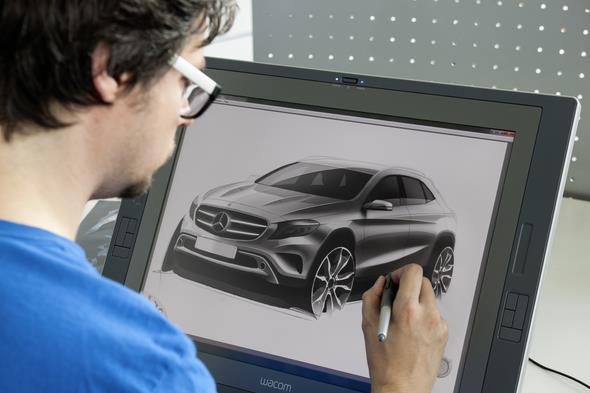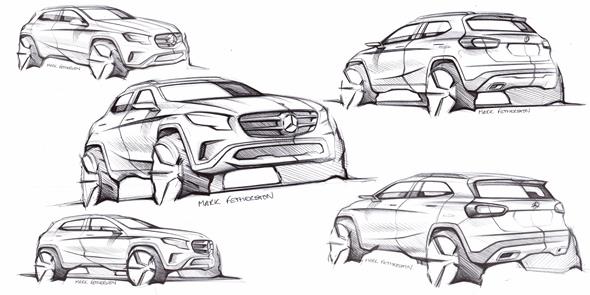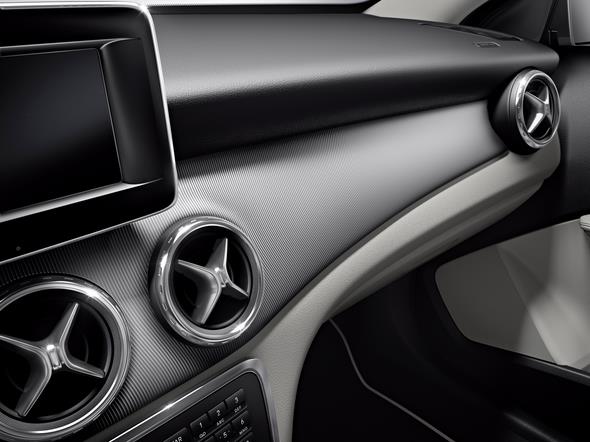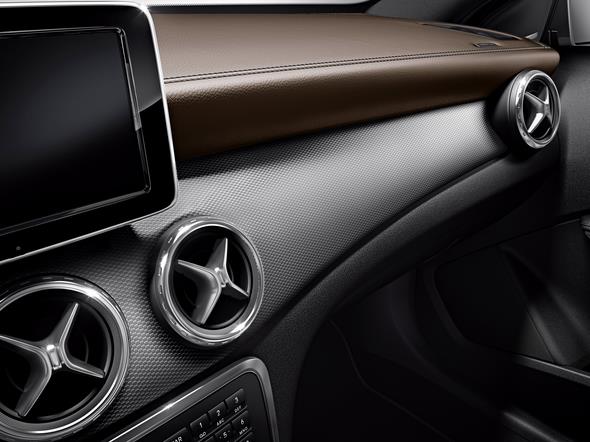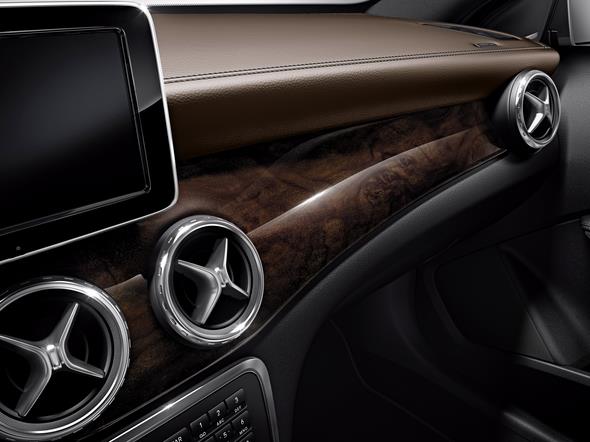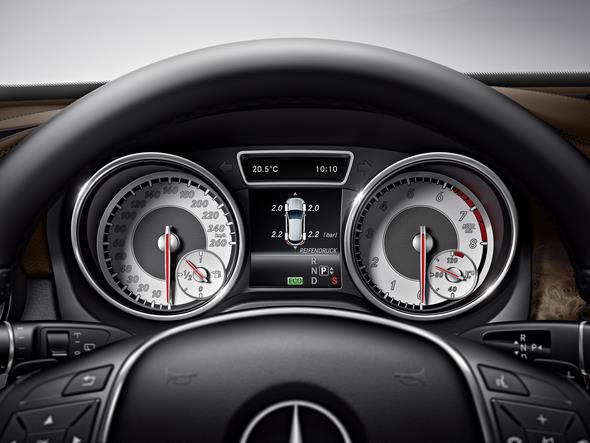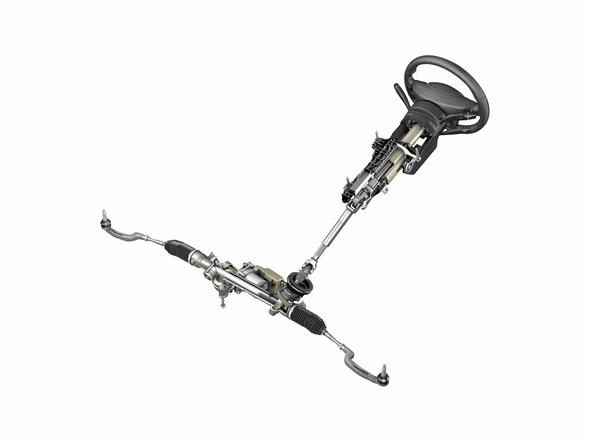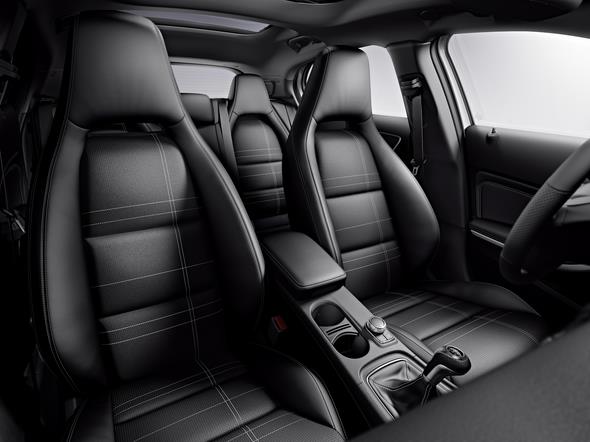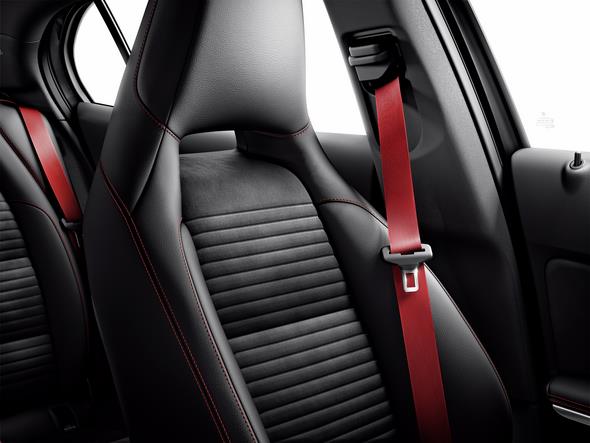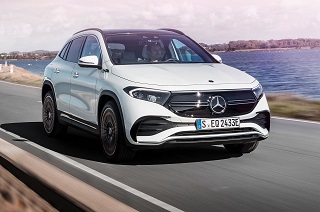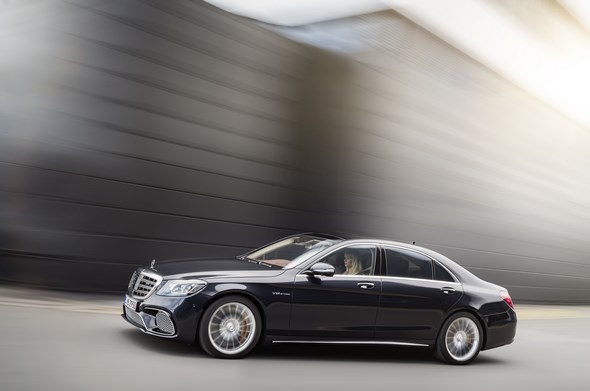Multi-talented: The new Mercedes-Benz GLA
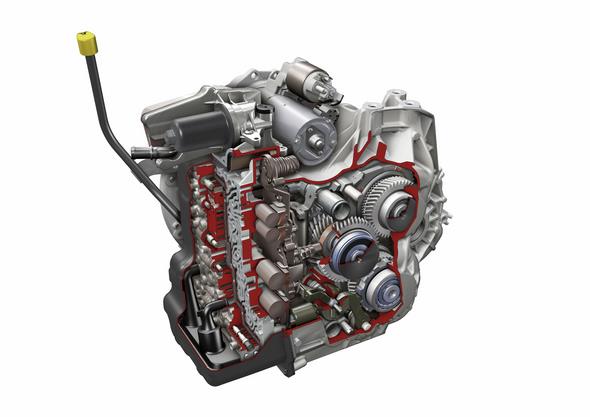
Fit for off-road excursions
Progressive in design, serene in day-to-day motoring and with good off‑road capability: a wanderer between automotive worlds, the Mercedes‑Benz GLA reinterprets the compact SUV segment in convincing style. It lightfootedly masters all day-to-day challenges and is also robust enough for off-road excursions.
The first Mercedes-Benz in the fast-growing compact SUV segment is highly manoeuvrable around town (length x width x height: 4417 x 1804 x 1494 millimetres), lively on country and pass roads and dynamic and efficient on the motorway (Cd figure 0.29). The high-quality appointments, developed with a loving attention to detail, and the flexible interior clearly position the GLA as a compact premium SUV.
As the first Mercedes SUV, the GLA is optionally available with the new generation of 4MATIC all-wheel drive featuring fully variable torque distribution.
The new GLA rounds off the extensive SUV portfolio from Mercedes-Benz. With five model series (GLA, GLK, ML, GL and G), the company offers the widest range of any European premium manufacturer and meets all the individual mobility wishes of its customers.
At the same time the GLA-Class is the fourth of a total of five new compact models from Mercedes-Benz.
The sales figures amply demonstrate how well the new compact models are received by customers: in 2013, worldwide 371,399 vehicles from the A and B-Class and the new CLA Coupé were delivered (+64%). Especially gratifying is the high conquest rate of the new A-Class: around 50 percent of the buyers in Europe come from other brands.
As a serene day-to-day companion the GLA has a flexible and variable interior. The rear seat backrests can not only be folded down completely, but are also adjustable for angle if required. The large luggage compartment (421 – 1235 litres) is well laid-out and can be loaded without difficulty thanks to the low loading sill and the wide tailgate, which opens and closes automatically as an option.
The particularly rigid body structure provides a reliable basis for a wide range of applications. Initially the power range of the 1.6 and 2.0-litre petrol engines will extend from 115 kW (156 hp) in the GLA 200 to 155 kW (211 hp) in the GLA 250.
The two diesel engines excel with dynamic torque and outstanding efficiency: The GLA 200 CDI develops 100 kW (136 hp), has a displacement of 2.2 litres and maximum torque of 300 Nm. It emits only 114 g of CO2 per kilometre. The GLA 220 CDI likewise has a displacement of 2.2 litres and develops 125 kW (170 hp) and 350 Nm.
All the engines feature the ECO start/stop function and comply with the Euro 6 emissions standard.
With the three lines “Style”, “Urban” and “AMG Line”, the “Night” package and “Exclusive” package as well as further optional extras, the GLA offers the broadest scope for individualisation.
Design: quality and self-assurance
Sensual purity as an expression of modern luxury – this was the focus for the designers, and is the design philosophy of Mercedes-Benz. The aim is to create clear contours and smooth surfaces that communicate high-tech while exuding an all-embracing emotional appeal.

The sensual purity is reflected in the core design values of tradition, emotion and progression. These make up the leitmotif which is accentuated differently depending on the model.
Mercedes-Benz creates a bridge between modernity and the avant-garde, between tradition and progression. Each model series has an assigned role and a very specific character, depending on the attributes on which the design focuses.
And yet a Mercedes-Benz is always recognisable as a Mercedes-Benz. Because in addition to incorporating new stylistic developments, in the interests of keeping tradition alive the designers draw from a gene-pool of styling features typical of the brand.
“With its striking features the GLA embodies our progressive thinking and enthrals with its off-road proportions,” says Gorden Wagener, Vice President Design Daimler AG. “The clearly defined surfaces convey power and serenity, and we have managed to combine as much emotional appeal as possible with as much purity as necessary.”

As an SUV, the new GLA combines the key design values of Progression and Tradition, and is the SUV of the future. It is an all-rounder with hallmark Mercedes-Benz SUV genes, but more youthful, sculptural and full of subtle drama.
The low greenhouse, raised vehicle body and large wheel arches give the GLA great appeal. The clearly defined surfaces are supplemented with sharp lines that provide definition and precision, varying the sculptured contours of the vehicle body which is sensitively modelled and subtly dramatic.
The prominent and self-assured upright front end with a central star lends a muscular and superior impression to the GLA. Powerdomes structure the bonnet as sporty features, and the twin-louvre grille accentuates the vehicle’s width.
An impressive front aspect is ensured by the headlamps and LED daytime running lamps. This iconic Mercedes-Benz design feature has been developed further using trifunctional fibre-optics, and gives the vehicle its characteristic light signature.

The front bumper features diamond-pattern grilles in front of the cooling air intakes. The optional fog lamps are integrated into the front bumper. A simulated underguard at the front and contrasting dark-grey cladding all-round emphasise the SUV characteristics of the GLA.
This cladding extends around the bottom edge of the vehicle like a frame and provides protection against stone impact.
The side view of the GLA likewise conveys power and serenity. Following the design philosophy, the “dropping line” emerges at the headlamp and extends to the rear wheel arch. The line of the beltline trim gradually rises from the rear door to the C-pillar.
Together the light-catching contour on the curvature and the counter-line to the dropping line at side sill height create an interplay of lines that lends the car flowing dynamism and subtle drama. At the sides the cladding follows the contours of the wheel arches and side sill panels into the rear bumper.
The side panel has depressions shaped like an excavator’s teeth to accentuate the SUV character. Standard-fit roof trim strips complete the impression; in combination with the “Style” line or the “Night” package, aluminium roof rails in high-gloss black are available as optional extras (black roof rails as standard in the Style line and the Night package, chrome-plated roof rails in the Urban and AMG lines). On request the GLA is fitted with tyres up to size 19-inch.
The muscular shoulders over the rear axle are further highlighted by the inward taper of the C-pillars. In combination with the divided tail lights, this emphasises the width of the rear end. It combines dynamic lines with an overall harmonious appearance.

This impression is heightened by the curved rear window and the sweeping chrome handle between the tail lights. Thanks to the divided tail lights, the loading hatch is pleasantly wide. The large, aerodynamically very effective roof spoiler is another eye-catching feature.
It takes up the structure of the rear roof cladding and accommodates the third brake light and various aerials. In the area of the rear bumper cladding there are other SUV-specific features such as a robust external load sill guard and a simulated underguard available in silver, dark chrome or high-gloss black.
Interior: attractive design features and high perceived quality
The muscular and imposing appearance of the exterior is systematically continued into the interior. The interior has a particularly high feel of quality that is achieved by the contours, and the choice and combinations of high-grade materials.
The heavy emphasis on horizontal lines, the dynamic design and the highly attractive design features are other high-quality attributes. The same applies to the great precision of joints and gap dimensions.

The dashboard consists of an upper and lower section, allowing surface structures that are different in look and feel. Matt and glossy 3D geometries (graining) create an attractive light effect.
The three-dimensional trim section of innovative membrane, aluminium or wood lends a new, modern touch to the interior. The matt satin finish of the wood trim further underscores the modern character and makes the surfaces particularly pleasant to the touch.
Five round air vents are integrated into the dashboard. As an exclusive GLA feature, bezels are optionally available around these circular vents whose
SUV-look echoes the underguard and side member claddings.
The bezels can be galvanised as an option. The direction of the airflow can be varied by butterfly-shaped inserts which can be optionally galvanised in silver-shadow.
The large, free-standing display has a high-gloss display facing in piano-black and a flush-fitting surround in silver-shadow. This gives the display a particularly high-quality look. A 3-spoke steering wheel with 12 function keys and a galvanised chrome clasp feature as standard. On request a sporty instrument cluster version with two tubes is available.

In this case there is a small dial instrument in each of the large dial instruments. When at rest the needles are in the 6 o’clock position.
The needle inlays are always in silver.
The wide choice of seat upholsteries in material (e.g. leather, fabric, fabric/leather) and colour combinations allows plenty of scope for individualisation. Sports seats with integrated head restraints are available as an optional extra.
The high quality of the sports seats is emphasised by the aperture in the lower section of the head restraint. On the rear of the front seats this aperture is framed by a surround in silver-shadow, and can have ambience lighting on request.
If the optional Load Compartment package is ordered, the backrest of the rear seat unit can be moved to a steeper position, the so-called cargo position. This enlarges the load compartment capacity by 60 litres, providing more space for bulky items while still allowing the rear seats to be used by passengers.

Set into a galvanised surround, the controls for the optional “electric seat adjustment with memory” are arranged on the interior door panels in typical Mercedes style – a unique feature in this segment. The interior door panels are likewise of extremely high quality.
The soft, matt surfaces extend right from the beltline to the door pocket. In combination with the lines or the Exclusive package the door armrests have a high-quality chrome trim strip and, as an option, ambient lighting.
Aerodynamics: as sleek as they come
With the GLA, yet another model series is set to become the leader in its segment with respect to aerodynamic efficiency. It has a Cd value of 0.29.
The drag area, Cd x A, which decisively affects fuel consumption from around 60 km/h, is also outstanding at 0.66 m2.
The good air flow characteristics, which are a major contributory factor to the vehicle’s low fuel consumption in everyday conditions, result from numerous aerodynamic optimisation measures.
These include a low A-pillar step with suitable A-pillar geometry and aerodynamically optimised exterior mirror housings. The rear end is also streamlined. The measures here include the roof spoiler lip and the aerodynamically shaped tail lights.
Rear spoilers at the sides ensure that the airflow breaks off for optimal aerodynamic efficiency. Seals in the front bumper (around radiator grille including headlamps) complement the aerodynamic measures.
Extensive underbody panelling, additional panelling in the middle area of the rear axle and an aerodynamically optimised rear silencer followed by a diffuser improve the flow of air beneath the underbody.
Numerous measures have also been taken to reduce wind noise in the GLA. These include a multi-level door sealing concept, additional sealing of the joint between the tailgate and the roof and side seals on the tailgate.
Particularly rigid window frames prevent the airflow from pulling on the doors at higher speeds, and reduce vibrations. External noise has also been minimised by the low A-pillar step mentioned above and by exterior mirrors connected to the body by a stem.
Engines and transmissions: dynamic expression of leadership aspirations
The GLA can be driven at a fuel consumption of only 4.3 litres per 100 km, setting new standards in its segment. Modern four-cylinder engines with turbocharging and direct injection, as well as an ECO start/stop function as standard, make for superior efficiency. The new GLA-Class also takes the lead in its segment with its dynamic performance figures.
Initially the power range of the 1.6 and 2.0-litre petrol engines will extend from 115 kW (156 hp) in the GLA 200 to 155 kW (211 hp) in the GLA 250.
The GLA 250 4MATIC sprints from zero to 100 km/h in only 7.1 seconds, underlining the GLA-Class’s leadership aspirations on the dynamics front.
It has a top speed of 230 km/h and a combined consumption figure of just 6.5 l/100 km (151 g CO2/km).

The two diesel engines excel with dynamic torque and outstanding efficiency: The GLA 200 CDI generates 100 kW (136 hp), maximum torque of 300 Nm and has a displacement of 2.2 litres. This engine has been reengineered for greater efficiency. The modifications include optimisation of the belt drive, a cylinder head package with different roller bearings and additional finishing, optimisation of the vacuum pump, aluminium pistons with optimised assembly clearances and a low-friction ring package, and the roller bearings of the Lanchester balancer shaft.
The GLA 200 CDI requires just 4.3 litres of fuel for 100 km, which equates to 114 g CO2/km. It is rated efficiency class A. The GLA 220 CDI with the same displacement of 2.2 litres generates 125 kW (170 hp) and 350 Nm.
All the engines feature the ECO start/stop function as standard. The engines are combined with a six-speed manual transmission or with the 7G-DCT dual clutch automatic transmission (standard for GLA 250, GLA 220 CDI and the 4MATIC models), which unites comfort and sportiness in a very special way.
Suspension: for guaranteed recreational fun
With the new GLA Mercedes-Benz is adding a new member to the successful SUV family. This compact model reinterprets the SUV concept in a new, modern way, because the GLA is less long-legged and imposing than previous SUVs, and therefore fits perfectly into the day-to-day urban lifestyle.
At the same time the optional 4MATIC all-wheel drive, the robust body structure and the variable interior concept guarantee plenty of recreational enjoyment. Motto: away from the daily routine. Rough terrain – the beach, loose ground, unsurfaced gradients – all of these are no problem for the GLA.
The chassis of the CLA features a McPherson front axle and an independent multilink rear suspension. Three control arms and one trailing arm per wheel manage the incoming forces. This means that longitudinal and lateral dynamics are independent of one another.
The wheel carriers and spring control arms are made of aluminium to reduce the unsprung masses. In the versions with 4MATIC, the rear axle carrier is isolated with rubber bushings for the benefit of ride comfort.

In all, there are three suspension variants to choose from: the comfort suspension as standard, the dynamic handling package with suspension lowered by 15 mm and Sports Direct-Steer system, plus the off-road comfort suspension (optional).
Compared to conventional systems, the electromechanical power steering provides better feedback to the driver and makes an important contribution to the vehicle’s overall efficiency, as the servo assistance only requires energy when the vehicle is actually steered. It also allows various steering assistance functions that are initiated by the ESP® control unit. These include countersteering when the vehicle oversteers, steering corrections when braking on surfaces with different levels of grip, reducing the effects of front-wheel drive on the steering and compensation of cross-winds and road camber.
The GLA has an extremely rigid body, providing the basis for stable and safe handling characteristics both on and off the road, as well as a high level of NVH comfort. There are additional reinforcements e.g. to the B-pillars, front damper domes, side members and underbody.
High traction reserves: 4MATIC all-wheel drive
Mercedes-Benz offers the GLA with the new generation of 4MATIC all-wheel drive with fully variable torque distribution as an option. This all-wheel drive system excels with high traction reserves and outstanding agility, combined with superlative driving safety and energy efficiency.

The components of the new 4MATIC include the power take-off to the rear axle, which is integrated into the 7G-DCT automated dual clutch transmission, and the rear-axle gear unit with integrated, hydraulically actuated multi-disc clutch. This set-up allows fully variable distribution of the drive torque between the front and rear axles. Additional benefits of this design are a lower system weight than is available from the competition and high efficiency.
Confident on light terrain: off-road functions
Models with 4MATIC are equipped with DSR (Downhill Speed Regulation) and an off-road transmission mode as standard. DSR is activated by a control button in the centre console, and assists the driver on demanding downhill stretches by maintaining a slow, manually selected vehicle speed within the physical limits when negotiating downhill gradients. This is done with the help of the engine and transmission control systems, and by specific braking intervention.
When the off-road transmission mode is selected using the transmission mode switch, the shift points and accelerator characteristics are modified so that the requirements for driving on light off-road terrain, and particularly on loose surfaces, can be met.
In combination with Audio 20 CD (standard) and COMAND Online (optional extra), the head unit can also be switched to an off-road display. The steering angle, the selected off-road transmission mode and a compass are displayed there. The roll angle in degrees, the gradient in percent and activation of Downhill Speed Regulation DSR are also indicated.
Smart safety: advanced assistance systems
Numerous driving assistance systems offer support in the GLA and reduce the driver’s workload. Standard-fit features for the SUV include ATTENTION ASSIST drowsiness detection and radar-based COLLISION PREVENTION ASSIST with adaptive Brake Assist, which now helps to avoid collisions from a speed as low as 7 km/h.
This feature combines with DISTRONIC PLUS (optional extra) to become COLLISION PREVENTION ASSIST PLUS. This incorporates an additional function: when a danger of collision persists and the driver fails to respond, the system is able to carry out autonomous braking at speeds of up to 200 km/h, thereby reducing the severity of collisions with slower or stopping vehicles.
The system also brakes in response to stationary vehicles at a speed of up to 30 km/h, and is able to prevent rear-end collisions at speeds of up to 20 km/h.

Established assistance systems, such as the optional Lane Tracking package with Blind Spot Assist and Lane Keeping Assist or Adaptive Highbeam Assist, are also available for the GLA. Active Parking Assist (optional) allows automatic parking in parallel and end-on parking spaces.
“Always on”: the multimedia systems
The latest multimedia generation deployed in the GLA boasts new functions, additional apps and a modified graphic colour scheme.
Daimler’s Digital Drive Style app concept, which together with the Drive Kit Plus for the iPhone® allows seamless integration of an iPhone® into the vehicle, has been extended. Highlights include Siri voice control and Glympse real-time location sharing. Glympse enables the user to share his or her current location with selected persons.
Additional functions include Facebook®, Twitter®, internet radio, AUPEO!™ personal radio and the advanced navigation system from Garmin® with internet-based real-time traffic information, an online POI search function including Street View™ and a 3D map display.
The COMAND Online multimedia system has also been extended. The latest generation offers an improved map display, an additional Bluetooth® profile
(to enable the internet to be accessed via iPhone®, for example), the display of images additionally in bmp and png formats and the real-time transfer of traffic data via LIVE TRAFFIC.
Here is an overview of the models and prices:
| Model | GLA 2001 | GLA 2502/ GLA 250 4MATIC1 | GLA 200 CDI1/ GLA 200 CDI 4MATIC2 | GLA 220 CDI2/ GLA 220 CDI 4MATIC1 |
| Number of cylinders/arrange-ment | 4 in-line | 4 in-line | 4 in-line | 4 in-line |
| Displacement (cc) | 1595 | 1991 | 2143 | 2143 |
| Rated power (kW/hp at rpm) | 115/156 at 5300 | 155/211 at 5500 | 100/136 at 3400-4000 | 125/170 at 3400-4000 |
| Rated torque (Nm at rpm) | 250 at 1250-4000 | 350 at 1200-4000 | 300 at 1400-3000 | 350 at 1400-3400 |
| Combined fuel consumption from (l/100 km) | 5.9 S | 6.0/6.5 S | 4.3/4.9 D | 4.4/4.9 D |
| Combined CO2 emissions from (g/km) | 137 | 141/151 | 114/129 | 115/129 |
| Efficiency class | C | C | A | A |
| Acceleration 0-100 km/h (s) | 8.9 | 7.2/7.1 | 10.0/9.9 | 8.3/8.3 |
| Top speed (km/h) | 215 | 235/230 | 205/200 | 215/215 |
| Price (euros)3 | 29,303.75 | 35,283.50/ 37,496.90 | 32,130.00/ 36,509.20 | 37,038.75/ 39,252.15 |
1 Available from March 2014, 2 Available from May 2014, 3 Sales price in Germany, incl. 19% VAT

The Mercedes-Benz management team on the GLA
“Element of our strategy for the future”
“The success of our compact vehicles is an important element of our strategy for the future. Following the CLA, we are opening up another interesting market segment with the GLA. During the next few years the pace at which
we introduce new products will remain high.”
Dr Dieter Zetsche, Chairman of the Board of Management of Daimler AG and Head of Mercedes-Benz Cars
“We are continuing with the systematic implementation of our strategy to significantly broaden our offerings in the compact segment. With the GLA we are fulfilling the requirements of many customers who are looking to drive an emotionally appealing compact car featuring off-road capabilities combined with the typical qualities of a Mercedes-Benz: innovation, efficiency, safety and excellent value retention.”
Prof Dr Thomas Weber, Member of the Daimler Board of Management responsible for Group Research and Head of Mercedes-Benz Cars Development
“With its fascinating design and high everyday practicality, the GLA will fill many new customers with enthusiasm for the Mercedes-Benz brand. With the GLA we are expanding the comprehensive SUV range from Mercedes-Benz with an emotionally appealing variant and as such are exploiting the constantly growing compact SUV segment.”
Ola Källenius, Member of the Divisional Board, Mercedes-Benz Cars Sales
“With its striking features the GLA embodies our progressive thinking and enthrals with its off-road proportions. The clearly defined surfaces convey power, poise and assurance, and we have managed to combine as much emotional appeal as possible with as much purity as necessary.”
Gorden Wagener, Vice President Design Daimler AG
The model range
Many ideas for individualisation
With the three lines “Style”, “Urban” and “AMG Line” and the “Night”, “Exclusive” and “AMG Exclusive” equipment packages, the GLA offers broad scope for individualisation. In the first year after market launch a particularly exclusive “Edition 1” (see next section) also will be available.
In addition, there are numerous optional extras to choose from, such as the large panoramic sliding sunroof, or the EASY-PACK tailgate, which can be opened and closed at the push of a button.
Striking 17-inch 5-twin-spoke light-alloy wheels, a radiator grille with two silver-coloured louvres and chrome inserts as well as a chrome finish on the loading sill protector help to provide a stylishly dynamic appearance in the case of the “Style” equipment line.
The interior features comfort seats in ARTICO man-made leather/Dourados fabric and also a multifunction steering wheel and shift lever in leather with silver-chrome highlights. The trim features a carbon structure.
The “Urban” line in turn includes a radiator grille with two silver-painted louvres and chrome inserts, 18-inch 5-twin-spoke light-alloy wheels and also a twin-pipe exhaust system with chrome-plated tailpipe trim integrated into the bumper.
Further highlights are the loading sill protector and waistline trim strip in chrome as well as a simulated underguard in dark chrome on the front and rear bumpers.
In the interior the sporty character is on display with sports seats featuring integral head restraints and a multifunction steering wheel in leather with perforated grip area. Details such as contrasting topstitching and wave-look trim round off the high-quality atmosphere.
Sportier handling and enhanced driving pleasure come courtesy of the “AMG Line” thanks to the dynamic handling package with suspension lowered by 15 mm and Sports Direct-Steer system.
On the exterior, eye-catching features include the AMG bodystyling components with inserts in the front splitter and side sill panels as well as rear apron trim in matt titanium grey. Further highlights include 18-inch AMG light-alloy wheels and a twin-pipe sports exhaust system with chrome-plated tailpipe trim integrated into the bumper.
The interior also boasts a sense of sportiness. Details include aluminium trim, sports seats in ARTICO man-made leather/DINAMICA microfibre, the multifunction sports steering wheel with flattened bottom section and the gearshift lever in leather with silver-chrome highlights.
The packages: Night, Exclusive and AMG Exclusive
The Night package builds on the Urban line or AMG Line. It lends the GLA a sporty, expressive character with striking exterior equipment features. These include selected black design elements.
The radiator grille sports two high-gloss black louvres and chrome inserts. Likewise in high-gloss black are the AMG 18- or 19-inch light-alloy wheels (based on the AMG Line), exterior mirrors, roof rails and waistline trim strips.
Dark-tinted glass from the B-pillar to the rear protects against prying eyes and simultaneously emphasises the sporty character.
The highlights of the Exclusive package (available for all three lines) include heated sports seats with 4-way lumbar support for driver and front passenger, leather-covered, like the multifunction steering wheel and the gearshift lever.
To match them, the instrument panel and door centre panels as well as the armrests in the doors and the centre console are trimmed with ARTICO man‑made leather. Contrasting topstitching and silver-chrome design elements also help to create an exclusive ambience.

The instrument cluster with silver-coloured backplate in chequered-flag look and red dial needles underscores the high-class, sporty character.
Building on the AMG Line, the AMG Exclusive package for the interior offers maximum exclusivity, individuality and a sporty character. Features include the heated sports seats with 4-way lumbar support, whose black RED CUT leather upholstery with red contrasting topstitching sets striking highlights.
The instrument panel and the armrest in the doors and the centre console are trimmed with matching ARTICO man-made leather. The multifunction sports steering wheel with flat bottom and perforated grip areas and the leather-trimmed gearshift lever emphasise the sporty character.
Red contrasting topstitching is also to be found on all these elements, indicating a loving attention to detail. Further features include sports pedals in brushed stainless steel with rubber studs or the instrument cluster with silver-coloured backplate in chequered-flag look and red dial needles.
Additional optional extras: still more practical details
The panoramic sliding sunroof with its large glazed area provides for an especially bright and friendly ambience in the interior. It consists of a fixed panoramic glass roof in the rear section and a top-sliding power sunroof with net wind deflector in the front.
In addition, two electric roller sunblinds provide shade for the passengers in strong sunlight. Numerous practical functions of the panoramic sliding sunroof ensure a high level of comfort on a journey.
In tilt position the glass roof automatically adjusts to the current speed in three stages. At high speed the glass roof is lowered. This reduces the noise level and air circulation in the interior. Conversely, at low speed the glass roof is raised again.
The open roof is closed when the air-recirculation switch is pushed or if it starts to rain (in conjunction with the optional). Light and Sight package).
The Light and Sight package creates a higher sense of perceived value in the interior and ensures the best possible visibility inside the vehicle. It comprises the function illumination, which enhances comfort and safety, and the ambient lighting for an enhanced interior atmosphere.

Illumination of the door handles and footwells makes orientation easier. Other details include illuminated vanity mirrors in the sun visors, an illuminated interior mirror and separately switched reading lamps in the rear.
The courtesy and warning lights for the driver and front passenger doors and the warning and background light in the tailgate serve to improve safety. The ambient lighting is controlled by means of a menu in the instrument cluster.
The rear lighting and the integral reading lamps are operated by buttons in the overhead control panel. The electronically controlled rain sensor makes for more relaxed driving in poor weather by automatically ensuring the appropriate wipe frequency of the windscreen wipers depending on the amount of precipitation.

Net pockets on the left and right and a folding box make for a tidier and safer rear passenger area with the Load Compartment package. The backrests of the rear seats can be moved to a 15 degree steeper position, the so-called cargo position.
In this way, the load compartment volume can be enlarged by 60 litres, from 421 to 481 litres. In the steeper backrest position the rear bench seat still can be used by passengers. Infant seats also can be fitted facing the rear. A 12V power socket in the luggage compartment completes this practical package.
To facilitate loading and unloading, the EASY-PACK tailgate can be easily opened electromechanically – either by pushing a button on the vehicle key, by means of a switch on the driver’s door, or by actuating the release handle of the tailgate.
It can be closed by pressing a button on the bottom edge of the tailgate. The closing action ceases automatically if an object prevents closing. To avoid banging the tailgate against the ceiling of a low garage, for example, the tailgate motion can be stopped in any position.
Limiting of the opening angle is activated by extended pressing of the closing button (with signal confirmation).
Under the microscope: GLA Edition 1
Special incentive at the start
For approximately one year after market launch of the GLA the particularly exclusive Edition 1 version will be available. The special model is recognisable by the “Edition 1” lettering on the front wings.
The Edition 1 of the GLA impresses with exclusive details both inside and out. The exterior is based on the Urban line with simulated underguard and roof rails in chrome.
Further features include bi-xenon headlamps, 19-inch AMG light-alloy wheels finished in high-gloss black, a black radiator grille louvre with chrome inserts, black-painted exterior mirrors, black waistline trim strips and dark-tinted glass starting from the B-pillars.
The Edition 1 will be available exclusively in the paint finishes cirrus white, orient brown metallic, mountain grey metallic and designo magno mountain grey (from autumn 2014).
Interior highlights include the DESERT DUST interior with
- seats which are only available in the Edition 1 upholstered in nut brown leather and Alvorada fabric with striking moccasin stitching
- 3-spoke multifunction sports steering wheel in leather, with perforated grip area and flattened bottom section
- sports pedals in brushed stainless steel with rubber studs
- aluminium trim with trapezoidal grain
- air vents with nozzle ring and cross element in silver chrome
- cover over the stowage compartment in the centre console
- cord floor mats with stitching in the appointments colour
black roof liner and Light and Sight package (single-tone ambient lighting; illumination of the stowage compartment in the centre console; illuminated make-up mirror for driver and front passenger; illuminated front door sill panels with Mercedes lettering; front and rear footwell lighting; interior mirror with additional lighting; rear lighting with integral reading lamps and locator lighting; windscreen wipers with rain sensor, courtesy and warning lights for driver and front passenger doors).

The design
Quality and self-assurance
As an SUV, the new GLA combines the key design values of progression and tradition, and is the SUV of the future. It is an all-rounder with hallmark Mercedes-Benz SUV genes, but more youthful, sculptural and full of subtle drama.
The muscular and imposing appearance of the exterior is systematically continued into the interior. The interior has a particularly high feel of quality that is achieved by the contours, and the choice and combinations of high-grade materials.
Sensual purity as an expression of modern luxury – this was the focus for the designers, and embodies the design philosophy of Mercedes-Benz. The aim is to create clear contours and smooth surfaces that communicate high-tech while exuding an all-embracing emotional appeal.
The sensual purity is reflected in the core design values of tradition, emotion and progressivism. These make up the leitmotif which is accentuated differently depending on the model.
Mercedes-Benz creates a bridge between modernity and the avant-garde, between tradition and progressivism. Each model series has an assigned role and has a very specific character, depending on the attributes on which the design focuses.
And yet a Mercedes-Benz is always recognisable as a Mercedes-Benz. Because in addition to incorporating new stylistic developments, and in the interests of keeping tradition alive, the designers draw from a gene-pool of styling features typical of the brand.
“With its striking features the GLA embodies our progressive thinking and enthrals with its off-road proportions,” says Gorden Wagener, Vice President Design Daimler AG. “The clearly defined surfaces convey power and serenity, and we have managed to combine as much emotional appeal as possible with as much purity as necessary.”

As an SUV, the new GLA combines the key design values of progression and tradition, and is the SUV of the future. It is an all-rounder with hallmark Mercedes-Benz SUV genes, but more youthful, sculptural and full of subtle drama.
The low greenhouse, raised vehicle body and large wheel arches give the GLA great appeal. The clearly defined surfaces are supplemented with sharp lines that provide definition and precision, varying the sculptured contours of the vehicle body which is sensitively modelled and subtly dramatic.
The prominent and self-assured, upright front end with a central star lends a muscular and superior impression to the GLA. Powerdomes structure the bonnet as sporty features, and the twin-louvre grille accentuates the vehicle’s width.
An impressive front aspect is ensured by the headlamps and LED daytime running lamps. This iconic Mercedes-Benz design feature has been developed further using trifunctional fibre-optics, and gives the vehicle its characteristic light signature.
The front bumper features diamond-pattern grilles in front of the cooling air intakes. The optional fog lamps are integrated into the front bumper. A simulated underguard at the front and contrasting dark-grey cladding all-round emphasise the SUV characteristics of the GLA.
This cladding extends around the bottom edge of the vehicle like a frame and provides protection against stone impact.
The side view of the GLA likewise conveys power and serenity. Following the design philosophy, the “dropping line” emerges at the headlamp and extends to the rear wheel arch. The line of the beltline trim gradually rises from the rear door to the C-pillar.
Together the light-catching contour on the curvature and the counter-line to the dropping line at side sill height create an interplay of lines that lends the car flowing dynamism and subtle drama. At the sides the cladding follows the contours of the wheel arches and side sill panels into the rear bumper.
The side panel has depressions shaped like an excavator’s teeth to accentuate the SUV character. Standard-fit roof trim strips complete the impression; in combination with the “Style” line or the “Night” package, aluminium roof rails in high-gloss black are available as an optional extra (black roof rails as standard in the Style line and the Night package, chrome-plated roof rails in the Urban and AMG lines). On request the GLA is fitted with tyres up to size 19-inch.

The muscular shoulders over the rear axle are further highlighted by the inward taper of the C-pillars. In combination with the divided tail lights, this emphasises the width of the rear end. It combines dynamic lines with an overall harmonious appearance.
This impression is heightened by the curved rear window and the sweeping chrome handle between the tail lights. Thanks to the divided tail lights, the loading hatch is pleasantly wide. The large, aerodynamically very effective roof spoiler is another eye-catching feature.
It takes up the structure of the rear roof cladding and accommodates the third brake light and various aerials. In the area of the rear bumper cladding there are other SUV-specific features such as a robust external load sill guard and a simulated underguard available in silver, dark chrome or high-gloss black.
Interior: attractive design features and high perceived quality
The muscular and imposing appearance of the exterior is systematically continued into the interior. The interior has a particularly high feel of quality that is achieved by the contours, and the choice and combinations of high-grade materials.
The heavy emphasis on horizontal lines, the dynamic design and the highly attractive design features are other high-quality attributes. The same applies to the great precision of joints and gap dimensions.
The dashboard consists of an upper and lower section, allowing surface structures that are different in look and feel. Matt and glossy 3D geometries (graining) create an attractive light effect.
The three-dimensional trim section of innovative membrane, aluminium or wood lends a new, modern touch to the interior. The matt satin finish of the wood trim further underscores the modern character and makes the surface particularly pleasant to the touch.
Five round air vents are integrated into the dashboard. As an exclusive GLA feature, bezels are optionally available around these circular vents whose
SUV-look echoes the underguard and side member claddings.
The bezels can be galvanised as an option. The direction of the airflow can be varied by butterfly-shaped inserts which can be optionally galvanised in silver-shadow.
The large, free-standing display has a high-gloss display facing in piano-black and a flush-fitting surround in silver-shadow. This gives the display a particularly high-quality look. A 3-spoke steering wheel with 12 function keys and a galvanised chrome clasp feature as standard. On request a sporty instrument cluster version with two tubes is available.
In this case there is a small dial instrument in each of the large dial instruments. When at rest the needles are in the 6 o’clock position.
The needle inlays are always in silver.
The wide choice of seat upholsteries in material (e.g. leather, fabric, fabric/leather) and colour combinations allows plenty of scope for individualisation. Sports seats with integrated head restraints are available as an optional extra.
The high quality of the sports seats is emphasised by the aperture in the lower section of the head restraint. On the rear of the front seats this aperture is framed by a surround in silver-shadow, and can have ambience lighting on request.
If the optional Load Compartment package is ordered, the backrest of the rear seat unit can be moved to a steeper position, the so-called cargo position. This enlarges the load compartment capacity by 60 litres, providing more space for bulky items while still allowing the rear seat bench to be used by passengers.
Set into a galvanised surround, the controls for the optional “electric seat adjustment with memory” are arranged on the interior door panels in typical Mercedes style – a unique feature in this segment.
The interior door panels are likewise of extremely high quality. The soft, matt surfaces extend right from the beltline to the door pocket. In combination with the lines or the Exclusive package the door armrests have a high-quality chrome trim strip and, as an option, ambient lighting.
Aerodynamics
As sleek as they come
With the GLA, yet another model series is set to become the leader in its segment with respect to aerodynamic efficiency. It has a Cd value of 0.29. At 0.66 m2 the drag area, Cd x A, which decisively affects fuel consumption from around 60 km/h, is also outstanding.
The good air flow characteristics, which are a major contributory factor to the vehicle’s low fuel consumption in everyday conditions, result from numerous aerodynamic optimisation measures.
These include a low A-pillar step with suitable A-pillar geometry and aerodynamically optimised exterior mirror housings. The rear end is also streamlined. The measures here include the roof spoiler lip and the aerodynamically shaped tail lights.
Rear spoilers at the sides ensure that the airflow breaks off for optimal aerodynamic efficiency. Seals in the front bumper (around radiator grille including headlamps) complement the aerodynamic measures.
Extensive underbody panelling, additional panelling in the middle area of the rear axle and an aerodynamically optimised rear silencer followed by a diffuser improve the flow of air beneath the underbody.
Numerous measures have also been taken to reduce wind noise in the GLA. These include a multi-level door sealing concept, additional sealing of the joint between the tailgate and the roof and side seals on the tailgate.
Particularly rigid window frames prevent the airflow from pulling on the doors at higher speeds, and reduce vibrations. External noise has also been minimised by the low A-pillar step and exterior mirrors connected to the body by a stem.
The anti-soiling measures on the exterior mirrors, side windows and rear window have special importance as a safety feature in wet weather. Dirt deflection is achieved by suitable channelling of the dirt-laden water that impacts the windscreen, the A-pillars and the exterior mirror housings.
The special design of the water deflector on the A-pillar prevents most of the water from flowing over onto the side window. The exterior mirror housings feature an aerodynamic design, with the result that only minimal soiling of the side windows, mirror glass and door handles occurs.
The body
Stable foundation
The GLA has an extremely rigid body, providing the basis for stable and safe handling characteristics both on and off the road, best-in-class NVH comfort and outstanding passive safety.
Weighing around 400 kilograms, 73 percent of the bodyshell is comprised of high-strength and ultra-high-strength steels. In the area of the side roof frame and the new C-ring structure in the rear, hot-shaped steels – the highest strength category possible for body steels – are used.
The specifications book for the GLA posed two special challenges to the body engineers: the optionally available glass sunroof, far and away the largest in its class – 64 percent of the roof surface is glazed in order to provide the passengers in all seats an airy sense of spaciousness and the large tailgate opening to facilitate loading of the GLA.
Given the torsional stiffness of the body, to achieve the same high level as with a closed steel roof the roof bows in this area had to be adequately replaced. This was achieved with a double-skinned roof frame to support the B-pillars, an enlargement of the cross-section at the D-ring (the rearmost member of the body), the use of hot-shaped steels, and with an extremely sturdy glass sunroof frame firmly bolted to and bonded with the body structure.
For the wide tailgate opening, which enables easy loading even with bulky objects, the engineers developed a new body structure. Along with the usual
D-ring an additional C-ring finds use.
These two closed ring structures form an extremely stable unit and ensure excellent torsional stiffness. They also compensate for the loads generated by the new spindle-type actuator of the optionally available automatic tailgate. Very large forces occur there especially when automatic opening begins.
In addition, the two rear shock-absorber strut fixtures are supported by the C-ring. This decisively improves the resistance to forces transmitted from the rear axle connection and thus the NVH (noise, vibration, harshness) characteristics in general.
The GLA body confirmed the success of these measures during the severe marathon “track & field endurance test” over 80,000 km.
Under the microscope: endurance testing
A vehicle lifespan at time lapse speed
Apart from purely road-based endurance tests, endurance testing of the new GLA-Class involved additional trials with stresses related to all-wheel-drive operations off paved roads.
During the nine months of endurance testing, an entire vehicle lifespan from customer perspective is simulated at time lapse speed. In all, 24 GLA models completed this marathon and other endurance tests, racking up a total of 1.8 million kilometres in the process.
Like the GLK-Class before it, which was renowned for its robustness, the GLA‑Class successfully was put through a special endurance test: the Track&Field endurance test.
This test, covering some 80,000 kilometres, is based on the road endurance tests and is supplemented with a number of special sections far off paved roads, a sprint programme at the Nürburgring Nordschleife and intensive trials in an Alpine environment.
Following positive experiences with the GLA and GLK the Track&Field endurance test will be the final examination for all compact Mercedes-Benz SUVs.
Compared to the ML, GL and G-Class models, which fulfil the requirements for the most extreme off-road applications, the Track&Field endurance test represents the performance profile that customers expect from a compact SUV: the main area of usage is on the road, however there are considerable expectations of the skills off the beaten track.
For this reason the track & field endurance test was elaborated, exactly mirroring the performance spectrum of a compact SUV based on the use profile of the customers.
But this does not mean the GLK and GLA are softies fit solely for boulevards: the demands made by the track & field endurance test are very harsh, as demonstrated for example by the off-road endurance runs conducted on a tank crew training ground.
During this nine-month GLA marathon the focus of the tests is on the durability and reliable operation of the new 4MATIC all-wheel drivetrain, the suspension and the comfort, control and assistance systems.
In addition, the track & field test ensures the strength and durability of the entire structure of the SUV body structure.
Documentation: collection of comprehensive data provides insights and enables projections
Simulating the entire lifespan of a vehicle within nine months requires a defined load scenario which the testing engineers realise with different “load collectives”.
The track & field endurance test includes extensive drives on country roads, motorways or in inner-city stop-and-go traffic – disciplines familiar from the conventional road endurance testing programme covering 150,000 kilometres.
In part, these stretches are covered by the GLA test vehicles towing a trailer with the maximum allowable towing capacity; this is intended to further intensify the structural loads on the body.
But the distance of 1.8 million kilometres covered by the 24 GLA long-distance runners only partially reflects the scope of the test disciplines. In the track & field endurance test the test drivers also check all the controls and operating devices according to an exactly defined procedure.
Always on board with the test driver: the computer to record all the data. It continuously records 190 different measured variables for the standard-fit monitoring and control systems and some 50 variables for additionally installed sensors.
To safeguard and evaluate the data they are transmitted to the Mercedes-Benz Technology Center (MTC). Subjective impressions of the experienced drivers help to further enhance production maturity.
All information is managed with Daimler’s own development tool FINAS (Vehicle Information and Administration System). Here the complete vita of the GLA prototypes with all measured data and vehicle-specific information such as stage of development, equipment, chassis, tyres or engine are saved, and pending or performed service or repair work is entered.
Aggravated conditions: Nürburgring, Alps, tank practice grounds
One kilometre at racing pace on the Nürburgring North Loop is equivalent to the load experienced during 20 kilometres in the real life of an automobile. The GLA has to complete 240 laps or about 5000 kilometres in the test.
This adds up to the equivalent of 100,000 “workaday” kilometres. The endurance tests in an Alpine environment are similarly demanding. One stretch in the Italian Alps covers a distance of 154 kilometres, includes nine Alpine passes and winds through 450 bends.
The vehicles have to cover differences in elevation of 4300 metres, and the total test distance after 20 laps on this surface is 3080 kilometres. The numerous winding bends impose a particular strain on both the chassis and the 4MATIC drivetrain as the vehicle accelerates out of the bends, and ensure that the dynamic handling control systems have their work cut out.
In view of its lineage, Mercedes-Benz requires that the new compact SUV also prove its mettle off surfaced roads. After all, in deference to the G-Class – the grandfather of all SUVs and cross-country vehicles with the star – only those vehicles that also meet certain minimum requirements off-road may carry a “G” in their name.
To ensure this, the track & field endurance test includes a run that very freely construes the term “primitive road” – the so-called tank ring road of a military training area of the German Armed Forces in southern Germany.
Where 62-tonne tracked monsters normally tear up the terrain, the GLA had to complete 1000 kilometres and thereby prove that it is capable of withstanding even such adverse conditions on a sustained basis.
The sequence of tests plays an important role in the track & field endurance test. Here, too, the track & field endurance test is aligned with the real-life demands on an SUV owned by the customer.
The individual on- and off-road disciplines are broken down into test cycles which are completed in varied patterns according to a defined distribution. For instance, a drive over country roads can be followed by an off-road excursion, or a city drive can be followed by a long stretch of motorway, just like in real life.
To cover various load scenarios for a customer-owned vehicle, in addition a number of disciplines involve different loads. For this purpose, either steel bars are firmly screwed to the vehicle floor in the rear, or the test drivers are accompanied by “water boys”: water-filled plastic torsos weighing 82 kilograms, strapped to the seats with standard seat belts.
Finale: complete disassembly and detailed evaluation
After completing track & field endurance testing the GLA models are disassembled and their individual components are spread out like an automotive puzzle.
Behind closed doors the specialist departments the development and test engineers subsequently evaluate all vehicle components, focussing on those areas where any anomalies have been observed during the endurance tests. If no further nonconformances are found in these sections, their fitness for series production can be certified.
However, if further problems or previously undiscovered problems arise, the engineers become active again until they find a perfect solution. If in doubt, GLA endurance test subjects are sent on their rounds again and the tests on devices such as the body testing facility or the road simulation test rig are intensified.
After the closed-door meetings over the disassembled GLA, further assessments follow: in the appropriate development units the engine, transmission and 4MATIC drivetrain then are completely disassembled, measured and scrutinised.
Track & field endurance test: one of many
The track & field endurance test rounds off the extensive endurance testing programme carried out worldwide by Mercedes-Benz. This endurance testing programme differs fundamentally from the development and tuning runs performed on new models; these are done additionally.
Whereas on these runs the characteristics laid down in the specifications book are verified, programmes like the track & field endurance test verify the reliability and durability of new models.
Other endurance tests:
- World endurance test: 50,000 km worldwide in extreme climatic and topographic conditions
- Trailer endurance test: 25,000 km with a special loaded trailer
- Rough road endurance test: 2000 km over extremely rough roads (“Heide” endurance test)
- Corrosion endurance test: 12-week testing in climate and corrosion chambers and on real-life routes
- Function tests: Checking of control systems and dynamic handling control systems on load-specific routes
- Hockenheim endurance test: 6000 km on the Grand Prix circuit at racing speed
- Full-load endurance tests over 30,000 or 50,000 km on cordoned-off high-speed tracks such as Nardo (southern Italy) or the Mercedes-Benz testing grounds in Papenburg, northern Germany
Active safety
Helpful assistants
Numerous driving assistance systems offer support in the GLA and reduce the driver’s workload. Standard-fit features for the SUV include ATTENTION ASSIST drowsiness detection and radar-based COLLISION PREVENTION ASSIST with adaptive Brake Assist, which helps in the GLA to protect against collisions from a speed of 7 km/h. Models with 4MATIC are equipped with DSR (Downhill Speed Regulation) as standard.
The radar-based COLLISION PREVENTION ASSIST system provides the possibly distracted driver with visual and acoustic warnings of identified obstacles and prepares Brake Assist for precision braking.
This braking is initiated as soon as the driver firmly presses the brake pedal. When an impending danger of collision is identified, COLLISION PREVENTION ASSIST calculates the precise braking force ideally needed to avoid an accident and makes the best possible use of any distance remaining.
DSR: support on downhill stretches
Models with 4MATIC are equipped with DSR (Downhill Speed Regulation) and an off-road transmission mode as standard. DSR is activated by a control button in the centre console, and assists the driver on demanding downhill stretches by maintaining a slow, manually selected vehicle speed within the physical limits when negotiating downhill gradients.
This is done with the help of the engine and transmission control systems, and by specific braking intervention.
Hill-Start Assist (standard feature of all GLA models), on the other hand, is able to prevent the vehicle from rolling back unintentionally when moving off on an uphill slope.
Electronic helpers: all the other assistance systems at a glance
Active Parking Assist, available as an optional extra on the GLA-Class, helps the driver to manoeuvre into and out of parking spaces. Twelve ultrasonic sensors located in the front and rear bumpers measure potential parallel and end-on parking spaces to the right and left of the road.
As standard, a search is made on the right; on the left only if the direction indicator is activated. If a suitable space is found, after stopping the vehicle and engaging reverse gear the driver can activate the automatic parking aid using the control panel of the multifunction steering wheel.
The system computes a suitable entrance path which requires a maximum of seven moves to park the vehicle. The driver is assisted while parking by activation of the electromechanical steering. However, the driver is still required to operate the accelerator and brake and select the gear. The parking speed is limited to 10 km/h. Parking on slight bends also is supported.
Automatic steering to exit the parking space is a new subfunction. If the vehicle has been parked using Active Parking Assist, the vehicle can be steered out of the longitudinal parking space in which the vehicle had previously been parked.
For this the driver has to engage reverse and actuate the turn indicator before activating – via the control panel on the multifunction steering wheel – the automatic assistance function for manoeuvring out of parking spaces. Here, too, the driver has to operate the accelerator, brake and gearshift.
As soon as the vehicle has assumed a sufficient angle to exit the parking space in one straight move, the wheels are set to the straight ahead position, the process ends and the driver assumes steering control again. The process is completed at the latest when the vehicle is at an angle of 45 degrees relative to the starting position.
A series of further assistance systems can be added to this:
- Adaptive Highbeam Assist: when vehicles are detected ahead of or oncoming to the vehicle, this system automatically dips the beams and adjusts the range of the headlamps appropriate to the distance. The driver benefits from a longer dipped beam range and does not generally need to switch manually between main and dipped beam.
- Intelligent Light System (ILS): with five light functions, automatically adapts to the weather and light conditions and the driving conditions. ILS comprises bi-xenon headlamps with variable light distribution and dynamic range adjustment for country roads, motorways and heavy fog, Adaptive Highbeam Assist, active curve light, LED daytime running lamps and headlamp cleaning system.
- Blind Spot Assist: detects vehicles in the critical zone by means of two radar sensors located at the sides at the rear of the vehicle and warns the driver by displaying a red triangle in the exterior mirror. If the turn indicator is actuated the red triangle begins to flash and a warning tone is emitted.
- Lane Keeping Assist: a camera behind the windscreen detects carriageway markings and can recognise if the car is about to leave a detected lane unintentionally.
- Attention Assist (standard): provides a warning when typical signs of drowsiness are detected. The system’s highly sensitive sensors observe the driver’s behaviour and can recognise – especially on the basis of how the steering wheel is being moved – if the driver is becoming drowsy or inattentive.
- Speed Limit Assist: a camera fitted behind the windscreen detects speed limit signs at the roadside and compares this data to information contained in the GPS system or the digital map. The relevant speed limit is then displayed in the instrument cluster.
- Hold function of brake (standard): when stopping, for example at traffic lights, the driver merely has to press the brake pedal slightly more firmly once (and can then take his or her foot off the brake) to keep the brake engaged until moving off again. The brake is released automatically when the driver steps on the accelerator.
- Reversing camera: integrated in the handle strip on the tailgate, the reversing camera features a wide-angle lens. When reverse gear is engaged, the image from the camera is transmitted to the screen of the Audio 20 system or the COMAND system. Static and dynamic guide lines assist the driver during manoeuvring.
- DISTRONIC PLUS: radar-based adaptive cruise control supports the driver at speeds between zero and 200 km/h by automatically adjusting the distance from the vehicles in front. In doing so it is able to apply the brakes to bring the vehicle to a complete standstill and also accelerate it again. As a result, the system is also particularly convenient in stop-and-go traffic. If the system detects that the distance is being reduced too quickly, it warns the driver with both visual and audible signals.
- Cruise control with Speedtronic:the cruise control maintains the preset speed. The additional SPEEDTRONIC function ensures that the saved speed is not exceeded. Both functions come as standard with the 7G-DCT dual clutch transmission and are optionally available for the models with manual transmission.
Passive safety
A protection programme for every eventuality
“One star is all you need” – the Mercedes-Benz safety philosophy also applies to the new GLA-Class. Its safety equipment includes belt tensioners and belt force limiters for the rear seats, too, the PRE-SAFE® anticipatory occupant protection system and the active bonnet for pedestrian protection.
The line-up also features seven airbags as standard and the Mercedes automatic emergency call system.
The new GLA-Class has passed the brand’s rigorous programme of crash tests. This includes not only some 30 different impact configurations, which are laid down as requirements for safety ratings and international type approval, but also nine proprietary crash tests, such as the roof-drop test or the pole impact test, developed by the brand itself. In the tests, as a matter of principle Mercedes-Benz uses the engines from which one can expect the highest loads on the body.
The bodyshell structure provides the basis for the high standard of passive safety, both in terms of material and with regard to its structural design. Key features of the front-end structure are the systematic implementation of an available crash length, load distribution over several planes, the new bulkhead and floor concept and the subframe as a deformation element.
A total of three longitudinal member planes – consisting of the straight front longitudinal members with inserted crash boxes made from extruded aluminium box sections, a second, upper plane as an extension of the load-bearing structure at the A-pillar node in the mirror triangle sector and a third plane at the bottom in front of the subframe – enable the controlled reduction of impact energy.
The subframe provides the torque support for the transverse engine/transmission block and serves to attach the components for the front axle and steering. It consists of several steel plates, some in ultra-high-strength steel, and a hydroformed tube.
In order to optimise its deformation properties, the subframe is connected via two aluminium struts leading forward to the aluminium radiator mount located under the front end. In the event of a frontal impact, forces can be discharged at an early juncture into the subframe via this third load path, in order to ensure the best possible energy dissipation.
A plastic crash wedge which is fitted at the rear of the front wheel arches helps to ensure that the wheels do not slide under the front doors in the event of a high-impact crash, irrespective of the turning angles. This means that it will be possible to open the doors, even after a serious accident.
The bulkhead also incorporates a special feature: so-called “skate runners” in front of the two middle longitudinal members discharge forces into the floor. The continuous floor structure consists of a total of four straight longitudinal members.
The tunnel roof reinforcements at front and rear combine with the tunnel to provide a further closed profile supporting the front end.
Protection in side-on crashes through controlled deformation
Rigid side structures and defined deformation management help to safeguard the survival space for occupants in the event of a side impact. Elements here include a member fitted diagonally in the rear footwell between centre tunnel and floor side wall which is intended to prevent the floor from being torn open in the event of side impact with a tree.
In the upper sector of the B-pillar high strength steels are used in order to ensure that as little intrusion as possible occurs, and that the passenger cell remains as intact as possible in the event of a side impact.
In the lower sector, on the other hand, the B-pillar is designed to be softer, in order to enable energy reduction. In this manner, deformation is directed to a few critical areas beneath the seating surface and transferred to the other vehicle side via the tubular structures in the front seats, transversal members and massive transmission bridge in the main floor.
Extensive pedestrian protection measures including active bonnet
The protection of those road users who are most at risk has always been a top priority during the development of Mercedes passenger cars. The new GLA-Class features numerous protective measures designed to help lessen the risk of injury to pedestrians.
For example, in order to reduce the loads which arise in the event of a pedestrian impact on the bonnet of the vehicle, the deformation space between the bonnet and the components beneath it has been optimised. This is achieved in part through the appropriate positioning of components such as control units or fluid reservoirs in the engine compartment.
The GLA-Class also features an active bonnet. In the event of a collision with a pedestrian, sophisticated sensors combined with intelligent algorithms trigger pyrotechnical actuators in the area of the bonnet hinges.
These raise the bonnet by 60 millimetres. The additional space which this creates between the bonnet and the components in the engine compartment means that a pedestrian’s head is subject to comparatively low internal acceleration forces on impact.
The deformation characteristics of the bonnet have been developed specifically to meet these requirements. Reductions in the impact loads can be achieved by using aluminium and reinforcing the inside face of the bonnet.
Intelligent restraint systems
The GLA-Class protects its passengers with up to nine airbags. The standard complement comprises driver and front-passenger airbag, a kneebag for the driver, large thorax-pelvisbags incorporated in the seat to protect the chest, stomach and pelvis area, and windowbags.
The windowbags extend over both rows of seats to the A-pillar triangle. They serve to protect the occupants’ heads from hard contact in the event of side impact and can also help to keep limbs inside the vehicle in an accident.
The driver and front passenger airbags operate in two stages, according to the expected severity of impact. The gas generator first of all fills the driver’s airbag with 80 and the front passenger’s airbag with 60 percent gas.
If a more severe impact is forecast, the second stage of the gas generator will additionally be activated after a delay and the airbags will be filled at a higher pressure level. Sidebags for the rear are optionally available.
The high safety expertise of the GLA-Class’s developers is reflected in a host of details. . The deformable steering column yields by up to 100 millimetres when the driver exerts pressure on the airbag as a result of forward displacement in an accident, for example.
The comfort features also reveal a fine touch: the driver’s airbag is connected to a vibration absorber in the steering wheel to reduce vibrations, for example.
Comprehensive precautionary measures in the rear
In developing the new GLA-Class, the Mercedes-Benz safety experts have also attached great importance to the safety of the rear-seat occupants. The new model therefore meets the relevant requirements of the Japanese and Chinese NCAP institutes, which also take account of factors such as the ease of use of the rear seat belts.
Experts believe that Euro NCAP will extend its rating programme to include rear-seat safety in the medium term. The GLA-Class is already prepared for this and is a role model in this respect – both within and beyond its own vehicle category – with features such as standard-fit belt tensioners and belt force limiters for the outer rear seats.
A torsion bar in the roller mechanism twists when the load on it exceeds a defined level. In this way the belt force is limited and with it the load on the seat occupant.
The GLA-Class’s features also include the standard-fit ISOFIX child seat securing system on the outer seats. Child seats can additionally be fixed to the vehicle by means of special anchorage points with top tethers.
PRE-SAFE® anticipatory occupant protection system
The PRE-SAFE® anticipatory occupant protection system is available in the GLA-Class as an option. This represents a further step in the ongoing democratisation of this innovation, which was premiered in the S-Class in 2002.
PRE-SAFE® from Mercedes-Benz uses the time between detection of a potential accident situation and a possible collision to initiate preventive protection measures, thus reducing the loads exerted on the occupants in the event of a crash by up to 40 percent.
Core features of PRE-SAFE® are reversible belt tensioning, the closing of side windows and sliding sunroof when critical lateral dynamics are detected and adjustment of the fully electric front passenger seat with memory function to an ideal position for maximum effectiveness of the restraint systems.
PRE-SAFE® is activated when one of the following parameters is met: emergency braking, panic braking, pronounced over- or understeering, critical steering movements or heavy support by adaptive Brake Assist.
Automatic Mercedes-Benz emergency call
In combination with COMAND Online, the new GLA-Class is equipped with the Mercedes-Benz emergency call system. As long as COMAND Online is connected to a mobile phone, the Mercedes-Benz emergency call system can rapidly automatically alert the emergency services in the event of a serious accident.
After the airbags or the pyrotechnical belt tensioners are triggered, the vehicle’s exact GPS position and vehicle identification number (VIN) are sent by SMS to a special emergency centre, with positional data also being transmitted using the DTMF method (dual-tone multi-frequency) at the same time.
Even if the occupants are unconscious or unsure of exactly where they are because they are on a holiday trip, for example, the emergency services alerted by the emergency centre will be notified quickly with accurate information. The driver can also make the emergency call manually as “MB emergency call” is always the first entry in the system phone directory.
On receiving the call, the emergency centre establishes voice contact with the vehicle occupants in a matter of seconds. A particularly practical aspect in an emergency is that communications are conducted not in the language of the country where the accident has occurred but in the language which the driver has preset in COMAND Online.
Other than any mobile phone communication charges, which would only arise in the event of an actual emergency call, no charges are incurred by the driver for the emergency call facility and no contractual relationship – other than the regular mobile phone contract – is required.
The engines
Four and 4×4
Initially the power range of the 1.6 and 2.0-litre petrol engines will extend from 115 kW (156 hp) in the GLA 200 to 155 kW (211 hp) in the GLA 250. The two diesel engines excel with dynamic torque and outstanding efficiency: the two choices are the GLA 200 CDI with 100 kW (136 hp) and the GLA 220 CDI with 125 kW (170 hp).
With the exception of the basic petrol engine, all engines can be combined with 4MATIC all-wheel drive. All the engines feature the ECO start/stop function and comply with the Euro 6 emissions standard.
The basis for the two petrol engine variants in the new GLA-Class is the all-aluminium M 270 engine with two chain-driven overhead camshafts and four-valve technology. In the new GLA-Class the M 270 is available in two output ratings.
The GLA 200 with a displacement of 1595 cc develops 115 kW (156 hp) and maximum torque of 250 Nm, which is available from 1250 to 4000 rpm. It sprints from zero to 100 km/h in 8.9 seconds and has a top speed of 215 km/h, but gets by on an average of 5.9 l/100 km of fuel, meaning CO2 emissions of 137 g/km.
The GLA 250 is powered by the top engine variant with a displacement of 1991 cc. The engine develops 155 kW (211 hp) and maximum torque of 350 Nm from 1200 to 4000 rpm. The GLA 250 is optionally available also as 4MATIC version.
Performance is at sports car level, with acceleration from zero to 100 km/h in 7.2 (7.1) seconds and a top speed of 235 (230) km/h (figures for 4MATIC version in brackets). Nonetheless it has the best fuel consumption in this class at 6.0 (6.5) l/100 km and CO2 emissions of 141 (151) g/km.
Agile right from low speeds: the diesel engines
Dynamic in its handling, extremely efficient and of exemplary cleanliness: the GLA 220 CDI, available exclusively in combination with the 7G-DCT dual clutch transmission.

The 125 kW (170 hp) top diesel variant, with a displacement of 2.2 litres and peak torque of 350 Nm, features a weight-optimised crankshaft and, with its individual bearing covers bolted from below and four counterweights, weighs around six kilograms less than an OM 651 of the same displacement, in the longitudinal-installation variant. The GLA 220 CDI is equipped with a multi-path exhaust gas recirculation system which reduces nitrogen oxide emission levels.
With 115 (129) g CO2 per kilometre and a combined fuel consumption of 4.4 (4.9) litres per 100 km, the GLA 220 CDI sets new standards in its segment (figures for 4MATIC version in brackets). Performance characteristics: 8.3 (8.3) seconds for the standard sprint and a top speed of 215 (215) km/h.
At 2.2 litres, the engine has a relatively large displacement, which makes it agile right from low speeds. Mercedes-Benz engine experts call this combination of large-displacement engine and low engine speeds “downspeeding”.
As a result it has been possible to make the ECONOMY mode of the 7G-DCT transmission decidedly economical and comfortable. If the driver selects transmission mode “S”, gearshifts are performed much faster and the ratio spread uses the rpm reserves of the engine for dynamic performance.
The engine of the GLA 200 CDI has the same displacement, while the maximum output is 100 kW (136 hp) and the maximum torque 300 Nm. This engine has been reengineered for greater efficiency.
The modifications include optimisation of the belt drive, a cylinder head package with different roller bearings and additional finishing, optimisation of the vacuum pump, aluminium pistons with optimised assembly clearances and a low-friction ring package, and the roller bearings of the Lanchester balancer shaft.
The combined fuel consumption of 4.3 (4.9) litres of diesel per 100 kilometres is outstanding in this output class (figures for 4MATIC version in brackets).
All models at a glance:
| Model | GLA 2001 | GLA 2502/ GLA 250 4MATIC1 | GLA 200 CDI1/ GLA 200 CDI 4MATIC2 | GLA 220 CDI2/ GLA 220 CDI 4MATIC1 |
| Number of cylinders/arrange-ment | 4 in-line | 4 in-line | 4 in-line | 4 in-line |
| Displacement (cc) | 1595 | 1991 | 2143 | 2143 |
| Rated power (kW/hp at rpm) | 115/156 at 5300 | 155/211 at 5500 | 100/136 at 3400-4000 | 125/170 at 3400-4000 |
| Rated torque (Nm at rpm) | 250 at 1250-4000 | 350 at 1200-4000 | 300 at 1400-3000 | 350 at 1400-3400 |
| Combined fuel consumption from (l/100 km) | 5.9 S | 6.0/6.5 S | 4.3/4.9 D | 4.4/4.9 D |
| Combined CO2 emissions from (g/km) | 137 | 141/151 | 114/129 | 115/129 |
| Efficiency class | C | C | A | A |
| Acceleration 0-100 km/h (s) | 8.9 | 7.2/7.1 | 10.0/9.9 | 8.3/8.3 |
| Top speed (km/h) | 215 | 235/230 | 205/200 | 215/215 |
1 Available from March 2014, 2 available from May 2014
The transmissions
Shifting comfort combined with efficiency
The 7G-DCT dual clutch transmission and the six-speed manual transmission enable a driving style that is both comfortable and dynamic. Both transmissions are extremely compact and share a series of components with each other.
The 7G-DCT dual clutch transmission is extremely compact, extremely variable with regard to adaptation of the engine speed thanks to seven gears, and incorporates an electric oil pump for start/stop capability.
It shifts gears without any interruptions in tractive power and combines the comfort of an automatic with the efficiency of a manual transmission. The GLA 250 and GLA 220 CDI are equipped as standard with the 7G-DCT transmission, which is optionally available for the GLA 200 and GLA 200 CDI.
The manual transmission, designed along similarly compact lines as a three-shaft transmission,is a close relative of the DCT. Extremely easy gear shifting, low shift forces, low internal friction and a low weight are among its most important characteristics.
The 7G-DCT dual clutch transmission: dynamic and efficient
Thanks to its seven gears it offers an exceptionally large spread of up to 7.99. This means that a very short transmission ratio is available when moving off on an uphill slope with a high payload, for example, while during cruising the engine speed can be lowered considerably.
At a length of 367 millimetres and a weight of 86 kilograms, the 7G-DCT is more compact and lighter than the transmissions in this torque class which have been available on the market to date.
The clutches take the form of oil-cooled multi-disc clutches. The specially developed hydraulic fluid is actively cooled, thus ensuring correct functioning of the transmission even under extreme conditions, despite the comparatively low filling level of six litres.
Excess engine heat can also be transferred to the transmission, which improves its efficiency.
For the first time in this type of unit, the transmission is supplied with oil by two oil pumps – one mechanical and one electric. The electric pump maintains the oil pressure when the engine is switched off via the start/stop function.
This means that the transmission is immediately operational when the engine is restarted and the vehicle can move off again without any delay. In addition, the electric pump is able to support the mechanical pump when peak loads apply, enabling a more compact and efficient design for the mechanical pump.
Another new feature is electric activation of the hydraulics for the parking lock, which is locked by mechanical means. This “park by wire” function enables the transmission selector lever to be positioned as desired: it is located in the form of a steering column lever on the right behind the steering wheel in the GLA-Class. In combination with the electric parking brake, additional space has thus been created in the centre console for additional stowage facilities.
Drivers have four transmission modes at their disposal:
- ECONOMY: the transmission performs gearshifts fully automatically and comfortably. The gears are selected with due regard to a particularly economical style of driving at low revs.
- SPORT: the transmission performs gearshifts fully automatically. The gear-change and response times are shortened, while the shifting speeds (revs) are increased.
- MANUAL: the driver operates the transmission manually using the gearshift paddles behind the steering wheel. The shifting speeds (revs) can be selected as desired.
- OFFROAD (standard in combination with 4MATIC): In this mode, the shift points and accelerator characteristics are also adapted in such a way that the requirements for driving on light off-road terrain and particularly on loose surfaces can be met.
In ECO or Sport mode, the driver is still able to intervene manually in the gear-shifting process via the shift paddles. The transmission reverts to the selected automatic mode after the paddles have remained inactive for twelve seconds, or after a longer delay when driving downhill or on winding roads.
The gear selected is displayed in the instrument cluster and a shift recommendation is made for a fuel-saving driving style.
A key factor contributing to the overall efficiency and dynamism of the GLA-Class is the closely coordinated operation of the transmissions and engines. A continuous exchange of data between the control units ensures that the engines run at the ideal operating point at all times.
The 7G‑DCT transmission is manufactured at Daimler’s Stuttgart-Hedelfingen plant.
The six-speed manual transmission: convenient manual gear-shifting
The three-shaft transmission is also very compact (length 345 mm) and light (dry weight 46 kg) and incorporates a number of special features for particularly pleasant gearshifting.
An integrated magnet on the gearshift shaft is detected by a Hall sensor. The idle position is identified in this way, making the start/stop function possible. The signal for reverse gear activates the reversing lights.
The large spread of 6.7 allows a reduction in engine speed while at the same time ensuring that sufficient tractive power is available when moving off with a fully laden GLA-Class and trailer up to a gross weight of 3.4 tonnes. The clutch is operated hydraulically and the gears are actuated via cables.
The overhead camshaft with third and fourth gears and the reverse gear do not run in the oil bath. This reduces drag torque, thus facilitating gear shifting at low temperatures in particular.
The three-cone synchronisation of the first two gears serves the same purpose, while the following gears are provided with two-cone synchronisation. The weight-optimised cast aluminium shift forks are installed on anti-friction bearings on the shift rods, in order to reduce the shift forces.
Under the microscope: 4MATIC
Added traction
As the first SUV, the GLA is optionally available with the new generation of 4MATIC all-wheel drive with fully variable torque distribution.
The most innovative components of the new 4MATIC include the power take-off to the rear axle, which is integrated into the 7G-DCT automated dual clutch transmission, and the rear-axle gear unit with integrated, hydraulically actuated multi-disc clutch.
This set-up allows fully variable distribution of the drive torque between the front and rear axles. Additional benefits of this design are a lower system weight compared with the competition and also high efficiency. As with their front-wheel-drive counterparts, all 4MATIC models also boast good energy efficiency.
Integrated power take-off unit (PTU) channels power to the rear axle
The new 4MATIC is combined with the 7G-DCT seven-speed automated dual clutch transmission. The power flow to the rear drive train is provided by a compact power take-off unit (PTU) which is fully integrated into the main transmission and supplied with lubricant from the latter’s oil circuit.
This configuration gives rise to substantial weight advantages over competitor systems that branch off power by means of an add-on component with its own oil circuit. In conjunction with the friction-minimised tapered roller bearings, the PTU thus achieves an excellent level of efficiency.
The low system weight of the 4MATIC system is not attributable solely to the PTU. Other weight-stripping measures include a compact rear-axle gear unit, inductively hardened, weight-optimised rear-axle side shafts and weight-optimised drive shafts. The system weight of this 4MATIC is up to 25 percent lower than in the all-wheel-drive versions offered by the competition.
The two-piece drive shaft is vibrationally decoupled. An axially moving joint at the front compensates for longitudinal movements of the engine transmission unit, while an elastic flexible coupling reduces the intrusion of high-frequency gearing vibrations at the rear-axle gear unit. To minimise crash loads, the drive shaft is fitted with an extendable element.
Completely new development with torque-on-demand rear axle
The electrohydraulically actuated multi-disc clutch integrated into the rear-axle gear unit is responsible for fully variable torque distribution. Fundamental operating principle: when the multi-disc clutch is open, the car is driven exclusively by the front axle.
When the clutch is closed, the rear axle comes into play. However, the drive torque can be shifted in fully variable mode between front and rear axle according to the given situation (torque on demand).
The system pressure to activate the rear axle is supplied in milliseconds by the gerotor pump that is integrated into the rear-axle gear unit. The pump is activated automatically as soon as only minimal speed differences arise between front and rear axles, and pressure control and therefore torque control to the rear axle is performed by means of a proportioning valve integrated into the rear axle.
Motoring enjoyment thanks to intelligent control systems
The 4MATIC is activated according to the basic principle of “as often as necessary, as rarely as possible”. This means that when the underlying conditions allow, the all-wheel drive compact models run in particularly economical front-wheel drive mode.
As soon as the driving situation requires, drive torque is channelled to the rear axle as appropriate. The reverse process takes place just as quickly: as soon as additional drive torque is no longer necessary at the rear axle – e.g. in case of heavy braking manoeuvres with ABS intervention – the rear drive train is deactivated and torque is reduced to zero.
In case of impending understeer or oversteer under load, the drive torque is first of all distributed in such a way as to stabilise the vehicle. Only if these measures fail to have a stabilising effect do the control systems adapted to the conditions of 4MATIC, such as ESP® or 4ETS, intervene and keep the vehicle on course.
With this strategy, the developers have managed to combine two key requirements defined in the performance specifications: optimum energy efficiency coupled with maximum dynamic handling and driving safety.
Suspension
The right set-up for every use
With the new GLA Mercedes-Benz is adding a new member to the successful SUV family. This compact model reinterprets the SUV concept in a new, modern way, because the GLA is less long-legged and imposing than previous SUVs, and therefore fits perfectly into the day-to-day urban lifestyle. There are three chassis and suspension set-ups to choose from.
The chassis of the CLA features a McPherson front axle and an independent multi-link rear suspension. Three control arms and one trailing arm per wheel manage the incoming forces.
This means that longitudinal and lateral dynamics are independent of one another. The wheel carriers and spring control arms are made of aluminium to reduce the unsprung masses. In the versions with 4MATIC, the rear axle carrier is isolated with rubber bushings for the benefit of ride comfort.
In all there are three chassis and suspension set-ups to choose from:
- In the standard-fit comfort suspension the setting of the McPherson double-tube shock absorbers has been selected so that the tension and compression forces at the front axle are at a ratio of 3:1. This reduces the dynamic wheel load fluctuations, benefiting the driving dynamics and driving safety of the vehicle. Small rolling and pitching motions and a reduced tendency to understeer at higher levels of lateral acceleration additionally improve vehicle control.
- The lowered suspension (in combination with the AMG Line[1] or the Dynamic Handling package) combines agility with ride comfort. Compared with the standard suspension the springs and dampers feature firm and sporty tuning and the level of the car is lowered by
15 millimetres. This reduces rolling motions and enhances driving stability. - With the off-road comfort suspension (optional) the body is raised by 30 mm. This results in improved off-road capability owing to higher ground clearance, a higher seat position and more striking off-roader looks. This suspension variant also features a distinctive steering system set-up.
Compared to conventional systems, the electromechanical Direct-Steer system provides better feedback to the driver and makes an important contribution to the vehicle’s overall efficiency, as the servo assistance only requires energy when steering actually takes place.
It also allows various steering assistance functions that are initiated by the ESP® control unit. These include countersteering when the vehicle oversteers, steering corrections when braking on surfaces with different levels of grip, reducing the effects of front-wheel drive on the steering and compensation of cross-winds and road camber.
As an optional extra, in the Dynamic Handling package a Sports Direct-Steer system with speed-sensitive power assistance and a variable steering ratio is available.
The ratio of the Sports Direct-Steer system in straight-ahead position is the same as that of the basic steering system, and becomes around
20 percent more direct between 5 and 90 degrees steering angle. Straight-line stability is thus retained and agility and manoeuvrability are even further enhanced. Comfort during manoeuvring likewise is improved as the full steering angle already is reached with 1.2 turns of the steering wheel.
With all engine variants the GLA features disc brakes all round. The floating callipers on the rear axle as well as the brake booster are made of aluminium. An especially convenient feature is the HOLD function familiar from the larger model series: when stopping, for example at traffic lights, the driver merely has to press the brake pedal slightly more firmly once to keep the brake engaged until moving off again.
The brake is released automatically when the driver steps on the accelerator. In versions with manual transmission the Hill-Start Assist function is able automatically to prevent the vehicle from rolling back unintentionally when moving off on an uphill slope.
The GLA is equipped with an electric parking brake, which operates by means of actuator motors acting on the callipers of the rear axle.
The parking brake is activated via a button under the light switch on the left of the dashboard, freeing up space on the centre console where the handbrake lever would normally be. If the button is pressed when travelling faster than 4 km/h, the parking brake functions as an emergency brake: all four wheel brakes are activated by the ESP® hydraulic unit.
In conjunction with the 7G-DCT automatic transmission, the parking brake offers a particularly convenient mode of functioning: when the driver accelerates sufficiently after fastening his seat belt, the parking brake is released automatically.
[1]The AMG Line is also available with comfort suspension and without Sports Direct-Steer system. In addition, the AMG Line can also be had with the off-road comfort suspension.Multimedia features
Always well informed and entertained
Two audio systems are available for the GLA, depending on the buyer’s budget: Audio 20 CD (standard) and the fully integrated COMAND Online multimedia system.
The radio aerials are integrated in the rear spoiler. The Drive Kit Plus for the iPhone® and the Digital Drive Style app allow seamless integration of an iPhone® into the vehicle.
The standard specification includes the Audio 20 CD system. It features a twin tuner, mp3-capable CD player and a USB connector in the centre console. The colour display has a diagonal of 14.7 centimetres. Thanks to a “cover art” function, the title images of the music albums currently being played are shown when their details are stored in the audio file.
An upper line in the Audio 20 CD’s menu navigation makes orientation easier and can be operated via the controller. The settings for the air conditioning system are also displayed on the telematics screen (when in use), as is the fuel consumption over the past 15 minutes.
There is a host of Bluetooth® functions as well: the mobile phone’s directory can now be automatically transferred en bloc when connected, and wireless music reproduction is possible from Bluetooth®-capable devices. Text messages can also be shown. Six loudspeakers with a total output of 100 watts are also part of the standard specification.
As an optional extra, Audio 20 CD can be combined with a 6-disc CD changer, Media Interface, harman/kardon® sound system, Convenience Telephony in the armrest, digital radio (DAB) and the Becker® MAP PILOT entry-level navigation solution.
The Becker® MAP PILOT makes a low-cost navigation function, which can also be retrofitted, available for the Audio 20 CD. Its advantages over aftermarket solutions include integrated operation via the central controls, voice output via the vehicle’s loudspeakers, display on the Audio 20 screen, a concealed location in the glove compartment and updating via an internet portal.
Mercedes-Benz developed the “Logic7” surround-sound system together with audio specialists harman/kardon®. This high-end system delivers three-dimensional sound as a natural 360-degree musical experience for all passengers.
The audio signals are distributed via a 450-watt multi-channel DSP amplifier connected to twelve high-performance loudspeakers. In conjunction with COMAND Online a multichannel listening experience with Dolby Digital 5.1 and DTS is possible.
The Media Interface is available as an optional extra. The universal interface enables mobile audio devices such as an mp3 player or iPod® to be connected to the vehicle’s telematics system.
These devices are then operated via the head unit, the central control unit or the steering wheel buttons. By making use of USB 2.0, the new generation of the Media Interface provides a quicker display and an expanded data selection.
Drive Kit Plus: seamless integration of the iPhone® into the vehicle
Daimler’s Digital Drive Style app concept together with the Drive Kit Plus for the iPhone® allows seamless integration of an iPhone® into the vehicle. Highlights include Siri voice control and Glympse real-time location sharing. Glympse enables the user to share his or her current location with selected persons.
Additional functions include Facebook®, Twitter®, internet radio, AUPEO!™ personal radio and the advanced navigation system from Garmin® with internet-based real-time traffic information, an online POI search function including Street View™ and a 3D map display.
COMAND Online: fast hard-disc navigation with 3D display
The high-end multimedia system is called COMAND Online. The latest generation offers improved map display, an additional Bluetooth® profile (to enable the internet to be accessed via iPhone®, for example), the display of images additionally in bmp and png formats and the real-time transfer of traffic data.
COMAND Onlineprovides internet access. Customers can either browse freely when the vehicle is stationary or call up a Mercedes-Benz app with pages that load extremely quickly and are also easy to use while driving.
The integrated apps include Google™ Local Search and weather as well as the option of downloading a route previously configured on the PC using Google Maps and sent to the vehicle.
Apps for Google™ Street View and Google™ Panoramio also are available. With Street View, places all over the world can be viewed from a 360-degree perspective and at street level.
Panoramio provides access to millions of photos taken at places around the globe by other users and made available by them. Street View and Panoramio enable users to collect comprehensive information about destinations and points of interest before the journey begins. With the News app, news from politics, business and technology can be obtained online in the vehicle.
The news is displayed in a way that makes it particularly easy to read. Via the Mercedes online shop (www.shop.mercedes-benz.com) further apps, such as stock market news or a parking space finder, can also be accessed.
The high-resolution colour display has a diagonal of 17.8 cm. The background colour of the central display is silver grey. The large screen can display photos and allows manual scrolling similar to a slide show.
Where the audio equipment is concerned, too, new forms of visualisation bring a fresh look and more convenient operation. The CoverFlow function, for instance, sorts the cover images of the stored music albums in carousel-like form so that GLA‑Class drivers can easily scroll through their music collection.
This collection may be very large as there are 10.8 gigabytes of memory available for compressed audio files mp3, wma, aac).
Greatest convenience is afforded by the Music Search function, which enables drivers and passengers to search the hard disc, SD memory cards, USB sticks, CDs and DVDs for specific music tracks and artists.
The search can be according to various criteria, for instance album, music category or composer. If a name needs to be entered, the software will also tolerate spelling mistakes.
The driver is therefore able to devote their full attention to the traffic. As a further advantage, the occupants are able to search all the connected media and devices simultaneously.
The fast hard-disc navigation of COMAND Online offers a 3D display with modelled city views. Also practical: driven routes can be recorded and retraced again later, specific personal destinations can be stored or imported via an SD card, plus four alternative routes can be displayed on the navigation map, including a particularly economical variant.
Mercedes-Benz customers in Europe receive the latest map updates for their COMAND Online multimedia system free of charge for three years. Authorised Mercedes-Benz dealers will upload updates for navigation data in 39 European countries into the navigation system as part of a visit to the dealership.
In Europe, COMAND Online also comprises Speed Limit Assist, which receives its information for traffic sign recognition via a camera and the navigation database. COMAND Online also includes the LINGUATRONIC voice-operated control system for audio, telephone and navigation.
The new “one shot” input function for the navigation system is particularly convenient, allowing the place and road to be spoken directly after one another. This function is currently available in seven languages and significantly enhances ease of operation.
With COMAND Online and LINGUATRONIC, in the GLA-Class music can also be easily searched for using voice control. The system first asks in which category it should conduct the search (artist, title, year).
The category is selected by speaking it out or by speaking the row number of the relevant category which appears on the screen. This is then followed by further questions about title, artist or album.
Under the microscope: Renewable raw materials
High-tech parcel shelf
All in all 46 components in the new GLA-Class with a total weight of 21 kilograms are made using natural materials. The load compartment cover is partially made from recycled paper and is only half as heavy as a conventional component weighs.
A multi-patented material composition and its manufacturing process furthermore reduce CO2 emissions during production by 60 per cent.
The load compartment cover of the GLA consists of eight layers, the core being formed by a honeycomb structure made from recycled paper. A new process developed by Mercedes-Benz simplifies its manufacture significantly: the eight layers of the composite material are joined, formed, laminated and cut to size in one step.
This consolidation of the production steps into a single operation and the use of recycled paper in the honeycomb core reduce CO2 emissions during the manufacture of the components by 60 per cent compared with the old process.
At the same time, with a weight of 1.2 kilograms the load compartment cover of the GLA has only around half the weight of a conventional component. This extreme lightweight design lowers the CO2 emissions during the use of the vehicle.
Over the entire lifecycle this results in CO2 savings of about 13 kilograms, as the company’s experts determined in their analysis for the environmental certificate.
Mercedes-Benz has registered four patents in all for the innovative manufacturing process and the material composition. The invention has furthermore scooped the MATERIALICA AWARD “Best of CO2“.
This component project is also among the winners of the “Environmental Leadership Award“, with which Daimler honours outstanding environmental projects in the group every year.
At Mercedes-Benz the use of renewable raw materials is concentrated primarily on the vehicle interior. In addition to the parcel shelf with a honeycomb core made from recycled paper, established natural materials such as coconut or wood fibres, wool and natural rubber are also used in the series production of the GLA.
There are many good reasons for using these natural substances: compared with glass fibres, the use of natural fibres usually results in reduced component weight.
Renewable raw materials help to counter the depletion of fossil resources such as coal, natural gas and crude oil. They can be processed using established technologies. The products which are made from them are usually easy to recycle. If recycled in the form of energy they have an almost neutral CO2 balance, as only as much CO2 is released as the plant absorbed during its growth.


















